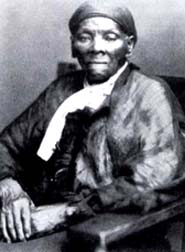| Harriet Tubman  AKA Araminta Ross AKA Araminta Ross
Born: c. 1821
Birthplace: Dorchester County, MD
Died: 10-Mar-1913
Location of death: Auburn, NY
Cause of death: Pneumonia
Remains: Buried, Fort Hill Cemetery, Auburn, NY
Gender: Female
Religion: Christian
Race or Ethnicity: Black
Sexual orientation: Straight
Occupation: Activist Nationality: United States
Executive summary: Underground Railroad Harriet Tubman, emancipator of hundreds and among the most famed abolitionists, was born into slavery and put to work when she was about five years old. Even as a young girl she was considered insolent and defiant, and frequently beaten by her owner and others to whom she was rented. At the age of about 12, she once blocked a doorway to protect another slave from an enraged overseer, who then beat her about the head with a heavy weight -- for the rest of her life she suffered from occasional dizziness and narcoleptic blackouts. In her early 20s she married a free black man, John Tubman, and continued working the fields as a slave but was allowed to sleep in his cabin. When she told him her dreams of escape, he told her that such talk was dangerous and stupid, and threatened to tell her owner. She never mentioned it to him again.
In 1849, a white woman whose identity remains unknown gave Tubman a piece of paper with two names written on it, and directions for finding a house where safe haven awaited. It was her first 'ticket' on the Underground Railroad -- the clandestine network of freed blacks and sympathetic whites who helped runaway slaves escape northward. At the first safe house she was bundled in a sack and taken by horsedrawn carriage to another house, where her clandestine journey continued. Traveling at night by following the North Star, she made her way to Philadelphia, where she found work and saved her earnings to fund her first trip back to the South, to rescue her brother and two other men.
Over the next decade Tubman made 19 increasingly dangerous round trips into slave territory, and the bounty on her head grew to $40,000. Always sought by Southern militia men, she would send word to trusted friends, who whispered to slaves about meeting places and times. To evade police and "white patrols" she employed such strategies as traveling south instead of north, changing direction only after authorities gave up. To keep infants quiet in the night, she drugged them with paregoric, an opium derivative. To keep older slaves from having second thoughts, she wielded a revolver and told deserters they would be shot. In a particularly daring move, she abducted her own parents in 1857 (it was, of course, impossible to seek their consent in advance) and brought them to her home in New York. She helped John Brown plan his ill-fated 1859 attack on Harpers Ferry, and meant to accompany him on the raid, but fell sick. In her work as the most famous conductor on the Underground Railroad, she brought more than 300 blacks to freedom, and told her friend Frederick Douglass that she never lost a traveler on the way.
With the outbreak of the Civil War, Tubman returned to the South as a spy and scout for the Union Army. In the dissident states she was renowned by blacks as "Moses", and slaves distrustful of Union soldiers' motives abandoned doubt on her word. On 2 June 1863, as news of her arrival in South Carolina spread in hushed murmurs, some 700 slaves escaped and made their way to the shores of the Combahee River. There they were taken aboard three boats under the command of Union Col. James Montgomery and accompanied by Tubman, and brought to freedom (and military service for the Union).
After the war she married a Union soldier, Nelson Davis, who was some twenty years younger than she, and cared for her aging parents at her home in Auburn, New York. She was ineligible for any military pension, but Congress granted her a "special pension" of twenty dollars monthly. With this and the royalties from her biography she established a retirement home for impoverished former slaves in Auburn, New York, where locals black and white knew her as "Aunt Harriet". She was also a frequent companion of Susan B. Anthony, and an adamant supporter of women's suffrage, and she was memorialized in Robert Hayden's poem "Runagate Runagate". Her parents were full-blooded Africans of the Ashanti tribe, and her tombstone is engraved, "Servant of God, Well Done." Father: Benjamin Ross (slave)
Mother: Harriet Green (slave, m. circa 1808)
Sister: Linah (slave, b. 1808)
Sister: Mariah Ritty (slave, b. 1811)
Sister: Sophia (slave, b. 1813)
Brother: Robert (slave, b. 1816)
Brother: Benjamin (slave, b. 1823)
Sister: Rachel (slave, b. 1825)
Brother: Henry (slave, b. 1830)
Brother: Moses (slave, b. 1832)
Husband: John Tubman (free black, m. 1844, sep. 1849, d. 1867, no children)
Husband: Nelson Davis (Union Army soldier, b. circa 1840, m. 1869, d. 1888, no children)
New England Anti-Slavery Society
National Federation of Afro-American Women
National Association of Colored Women
New England Women's Suffrage Association
National Women's Hall of Fame
Born into Slavery
Flogged
Brain Injury
Escaped from Slavery 1849
Underground Railroad
Ghanaian Ancestry
Appears on postage stamps:
USA, Scott #1744 (13 cents, issued 1-Feb-1978)
Requires Flash 7+ and Javascript.
Do you know something we don't?
Submit a correction or make a comment about this profile
Copyright ©2019 Soylent Communications
|